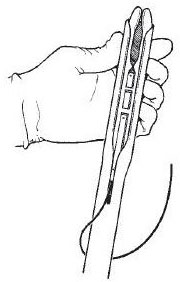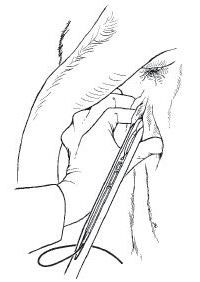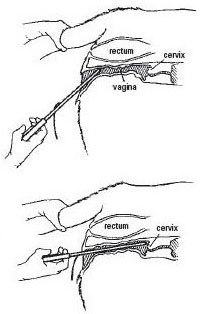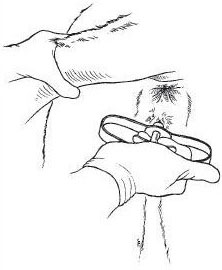Editor’s note
The introduction to this guide appears below. To view the PDF of the entire guide, please select the “Download this publication” button.
Estrus synchronization of beef cows and heifers is simple and easy, due to extensive research efforts at the University of Missouri and other institutions. Several protocols and other resources have been developed to allow beef producers to effectively synchronize estrus and ovulation among the herd. Estrus synchronization will involve use of one or more of the following compounds: prostaglandin F2a (PG), gonadotropin-releasing hormone (GnRH), a progesterone-releasing intravaginal controlled internal drug release (CIDR), or the progestin feed additive melengestrol acetate (MGA). This publication provides an overview of the function, handling considerations, and proper administration of these products.
Prostaglandin F2a
Several PG products are available from a variety of pharmaceutical manufacturers. In estrus synchronization, PG induces regression of the corpus luteum among responsive cyclic cows or heifers. As a result, administering PG at the proper time allows for expression of estrus and ultimately ovulation. Note that required dosage and route of administration varies from product to product based on formulation (Table 1). Follow the labeled dose.
- Store PG at room temperature out of direct light in a temperature-controlled building.
- Wear gloves when handling PG, and wash immediately with soap and water if skin contact occurs.
- Administer product with an 18 or 20 gauge 1.5-inch needle. Change needle before drawing up more product, so as not to contaminate the whole bottle.
- We recommend using single dose syringes; be conscientious that appropriate dose is administered if using multi-dose (e.g., pistol grip) syringes.
- Beef Quality Assurance standards suggest changing needles after every animal and performing intramuscular injections in the neck rather than the hip or rump.
- Follow appropriate injection procedures and avoid injecting through wet, dirty hide.
- Know the pregnancy status of cows or heifers prior to administering PG. Prostaglandin F2a can cause abortion in cattle up to around 5 months of gestation.
- Prostaglandins are involved in several physiological processes including induction of labor and respiratory functions. Women who are pregnant or may be pregnant and individuals with respiratory conditions (e.g., asthma) should avoid handling prostaglandin products.
- Note that, in timed AI protocols, the time of the final PG administration dictates when timed AI is performed. Online estrus synchronization planning tools are available to assist in scheduling.
Table 1. Prostaglandin F2a (PG) products currently available.
| Hormone | Biological action in estrus synchronization | Product name | Dosage | Route of administration |
|---|---|---|---|---|
| Prostaglandin F2a | Induce luteal regression | In-Synch | 5 mL | IM injection |
| ProstaMate | 5 mL | IM injection | ||
| Lutalyse | 5 mL | IM injection | ||
| Lutalyse HighCon | 2 mL | IM or SQ injection | ||
| Estrumate | 2 mL | IM injection | ||
| estroPLAN | 2 mL | IM injection | ||
| Synchsure | 2 mL | IM injection |
Gonadotropin-releasing hormone
Multiple GnRH products are available commercially and label-approved for use in estrus synchronization and/or treatment of cystic ovarian follicles. Table 2 provides a full list of all commercially available GnRH products. Dose varies slightly from product to product based on formulation; follow labeled dose. Administration of GnRH induces a surge of luteinizing hormone (LH), which initiates the ovulatory process among cows or heifers with mature dominant follicles.
In estrus synchronization systems, you may see GnRH administered at the start of a synchronization protocol or midway through the protocol to reduce variation among cows in stage of follicular development. This ultimately results in cows expressing estrus in a shorter window of time. It is also common for GnRH to be administered when timed AI is performed in order to induce ovulation among cows or heifers that have not yet expressed estrus.
- Store GnRH products in a refrigerator, and use a cooler and ice to keep product cool during transport and use.
- Wear gloves when handling GnRH, and wash with soap and water if skin contact occurs.
- Handle GnRH out of direct light, using shade or facing away from sun when drawing up product.
- Administer product intramuscularly (IM) with an 18 or 20 gauge 1.5-inch needle. Change needle before drawing up more product so as not to contaminate the whole bottle.
- We recommend using single dose syringes; be conscientious that appropriate dose is administered if using a multidose (e.g., pistol grip) syringe.
- Beef Quality Assurance standards suggest changing needles after every animal and performing intramuscular injections in the neck rather than the hip or rump.
- Follow appropriate injection procedures and avoid injecting through wet, dirty hide.
Table 2. Gonadotropin-releasing hormone (GnRH) products currently available.
| Hormone | Biological action in estrus synchronization | Product name | Dosage | Route of administration |
|---|---|---|---|---|
| Gonadotropin-releasing hormone | Induce ovulation of a mature ovarian follicle | Cystorelin | 2 mL | IM injection |
| Factrel | 2 mL | IM injection | ||
| OvaCyst | 2 mL | IM injection | ||
| Fertagyl | 2 mL | IM injection | ||
| GONAbreed | 1 mL | IM injection |
Controlled internal drug release (CIDR)
The CIDR, which stands for “controlled internal drug release,” is an estrus synchronization product manufactured by Zoetis. It is a T-shaped, silicone-covered intravaginal insert. The U.S. version marketed for beef and dairy cattle contains 1.38 grams of progesterone. Progesterone is a steroid hormone made naturally during the luteal phase of the estrous cycle, as well as during pregnancy. Progesterone in the CIDR is absorbed through the vaginal wall and ultimately into the bloodstream.
In estrus synchronization systems, a CIDR may be used for multiple reasons. In a cyclic heifer or cow, CIDR inhibit estrus and ovulation for a period of time as part of the treatment schedule. In peripubertal heifers or anestrous cows, treatment with a CIDR helps to induce normal estrous cyclicity.
- Wear gloves whenever handling a CIDR, since progesterone can be absorbed through the skin.
- A CIDR is placed into the vagina of a cow or heifer using a plastic applicator (Figure 1). It is critical to keep both the applicator and the CIDR clean during the insertion process.
- Use a two bucket system to clean and disinfect applicators after each use. With one bucket of water, wash manure and other contaminates from the applicator. With a second bucket of water containing a small amount of chlorohexidine solution, disinfect the applicator before loading another CIDR.
- Apply lubricant to the CIDR and applicator before insertion. We suggest using a lubricant that contains a small amount of chlorohexidine disinfectant.
- Wipe the vulva of the cow or heifer before inserting the CIDR (Figure 2) to minimize introduction of manure into the reproductive tract.
- Insert into vagina CIDR at a slight upward angle (Figure 3).
- Press the end of applicator to push the CIDR out (Figure 4), allowing the wings of the CIDR to grip the inner walls of the vagina, and remove the applicator.
- Verify that CIDR does not protrude from the vulva and that the tail of the CIDR curls down around the body of the animal rather than sticking up.
- Remember to wash and disinfect the applicator before loading another CIDR.
- When it is time to remove the CIDR later in the estrus synchronization program, simply pull on the CIDR tail.
CIDR retention is rarely a problem, but pulling of CIDR tails by curious heifers has been known to occur in drylot situations. To address this, consider trimming the plastic tail of the CIDR to a shorter length prior to insertion.




Melengestrol acetate
Melengestrol acetate (MGA) is an orally active progestin feed additive marketed as MGA by Zoetis or as HeifermaX by Elanco US. When consumed by heifers on a daily basis at the recommended dosage, MGA suppresses expression of estrus and inhibits ovulation. Although used effectively among mature cows in published research, MGA is only label-approved for use in heifers, either for estrus synchronization of replacement breeding heifers or for suppression of estrus and improved rate-of-gain in feedlot heifers.
Melengestrol acetate is a very cost effective option for use in estrus synchronization. However, animals that fail to consume the required amount of MGA on a daily basis may prematurely return to estrus during the feeding period. This can be expected to reduce the overall response to estrus synchronization. Therefore, effective use of MGA requires good attention to detail when feeding.
- Feed MGA at a rate of 0.5 milligram per animal per day in a grain or a protein carrier.
- Feed MGA in a sufficiently small ration mix such that all heifers consume the entire dose of MGA at one time rather than slowly throughout the day.
- If heifers are not acclimated to supplementation or to feed bunks, it is recommended to start feeding the feed carrier alone, without inclusion of MGA, well in advance of when you plan to start your synchronization protocol. This can acclimate heifers to consuming the carrier.
- For heifers on pasture receiving supplementation, supplement products are available with MGA included in the mix specifically for use in estrus synchronization. Feed at the recommended pounds per head per day to ensure adequate dosage of MGA.
- For heifers receiving a total mixed ration (TMR) in a drylot, alteration of the feeding schedule may be necessary. As one approach, consider MGA into only a portion of the TMR. Feed the portion of the TMR containing MGA first, and allow full consumption of that portion prior to feeding the remainder of the TMR.
- Adequate bunk space should be provided so that all animals may consume feed simultaneously.
- All heifers in the group should be allowed to approach the feed bunk prior to feeding, so that all heifers have an opportunity to consume an adequate dose of MGA.
- Observe heifer behavior each day MGA is fed to ensure that estrus expression is not occurring among animals in the group.
In estrus synchronization, MGA is typically fed to heifers during a presynchronization period of the protocol (e.g., for a period of 14 days). Heifers will exhibit estrus beginning 2 to 3 days after MGA is withdrawn from the feed, with estrus onset occurring in the group over a period of 6 to 7 days. Heifers should not receive AI or be exposed for natural service during this initial subfertile estrus after presynchronization. Instead, AI or bull introduction should occur at the subsequent estrus.
As with use of a CIDR, a benefit of use of MGA is induction of normal estrous cyclicity among peripubertal heifers as well as effective control of the estrous cycle in cycling heifers. This makes long-term progestins an effective tool at increasing the proportion of heifers the conceive early in their first breeding season.
Note that these long-term protocols require time, so it is important to plan in advance. Some protocols require you to be prepared to start feeding MGA up to a month prior to the start of your breeding season.